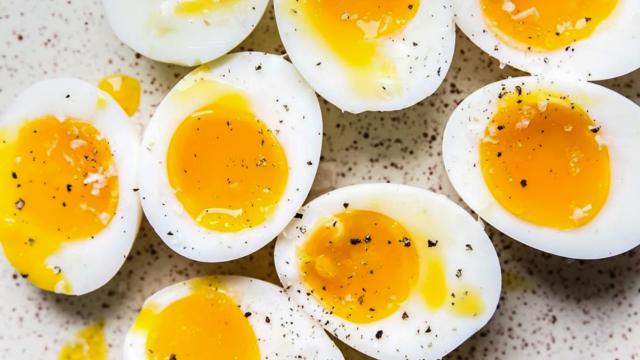There are lots of tricks to making poached eggs. Add vinegar to the water, swirl the water into a vortex, slip the egg gently into the water from a mug, plop the egg into the water so its momentum holds it together. Boil the water, simmer the water, once the egg is in turn the heat off altogether.
Well, here’s my number one poached egg tip: Don’t.
Poached eggs are great – in a restaurant. Professional chefs know how to make them, and I won’t belittle the pleasure of cutting into a perfectly poached egg, topping some sort of Benedict tower, warm yolk mixing with hollandaise sauce.
But without extreme skill or special equipment, a homemade poached egg is liable to be a lumpy, misshapen mess, half its white lost to frothy boiling water, with undercooked whites or overcooked yolks, and, honestly, usually very ugly.
If you want cooked whites and runny yolks, with consistent results every time, I have two words for you: soft boil.
The only advantage poached eggs have over soft-boiled is that they lay flatter — and are roughly the same diameter as an English muffin. But soft-boiled eggs are superior in every other respect: they are easier, cleaner, and more consistent than poached eggs. You can also cook them in larger batches.
How to make the perfect soft-boiled egg
Bring a pot of water — enough water to cover your eggs — to boil. Add your eggs, slowly, so they don’t crack. Cook for six and a half minutes, gently moving the eggs around once or twice so the yolks are centred in the egg.
Remove the eggs with a slotted spoon and rinse under cold water for thirty seconds. Peel. Place atop whatever you want to place them atop. Admire their symmetry, their beauty, and their ease. Never look back.
If you want more egg cooking tips, check out this guide to scrambling your eggs in a jar – it’ll change your life.
This story has been updated since its original publication.

Comments
9 responses to “Why Would You Ever Poach an Egg When You Could Soft-Boil It?”
This article conveniently skips the part where you have to peel the eggshell off, which is always, 100%, guaranteed disaster – especially with a soft boiled egg, because you end up ripping through the white and scalding your fingers with molten yolk.
So yeah, I’ll stick with poaching my eggs for 2 minutes in the microwave thanks.
Yeah, exactly, peeling a hot, soft boiled, egg is no small feat, and certainly prone to ruin… There’s a heap of easy method for poaching eggs, I’d recommend trying and mastering one of those instead.
Why? Because I like poached eggs cooked with a bit of vinegar and they taste completely different to boiled eggs.
They may be a bit misshapen but that doesn’t really factor at all, and it’s really not difficult to get them cooked right with a little bit of practice.
Here is a method that I use that gives you what could be easily confused as a poached egg, with perfect whites and a runny yolk, but is in fact a fried egg . And is a lot easier that trying to poach it, it will also lie flat and, you don’t have to try and peel a hot egg.
Have I got you excited?
Here are the steps:
– heat a small frying non-stick pan/skillet at medium heat. You can add a drop of olive oil if you want, but if your non-stick frying pan is good you won’t need it.
-crack your egg into the frying pan, making sure the heat isn’t too high. You don’t want the bottom of the egg to go brown.
– after approximately 30-60 seconds the whites should start solidifying.
– then pour 1-2 tablespoons of water around the edge of the pan and immediately put a lid on the pan. It is best if you have a clear lid, because then you can watch the progress of the cooking.
– the water will boil almost instantaneously and create steam that will cook the egg on all sides, top and bottom.
– through the clear lid you will see the top of the yolk starting to turn white. Once you can’t see the yellow of the yolk any more, the egg is ready and can be served.
The entire process will take approximately 3-5 minutes depending on your stove top. The top layer off eggwhites will be thinner than the bottom, but ideal for dipping in toasted bread soldiers.
Enjoy.
This is exactly what I do. And once you cut up the egg on your toast (which is what I do, always) the end result is exactly the same well cooked whites and runny yolk as a poached or soft boiled egg, with none of the problems associated with either.
You clearly should have written this article.
Poached eggs are easy; just use lots of vinegar in the water, no salt, use a lot of water (the drop through the water is important), and don’t have it on a rolling boil. Fresh eggs are better too.
Finally, someone said it – the key is fresh eggs…
They certainly help; a really fresh egg basically poaches itself, but even with week old supermarket eggs I get good results with a good amount of vinegar
Soft boiled is it the same as Mollet eggs? Mollet is French for soft. But then I cooked a dish from my favourite cookbook and told my guests it was Spanish. They told me it was Portuguese (they had a family history in Portugal).
Portugal and Spain are close probably like Mollet eggs and soft boiled.
The one thing that a number recipes do not spell out is the temperature of the food stuff to be cooked. Eggs out of the fridge or eggs at room temperature? If at room temperature how long do have leave the eggs out of the fridge?